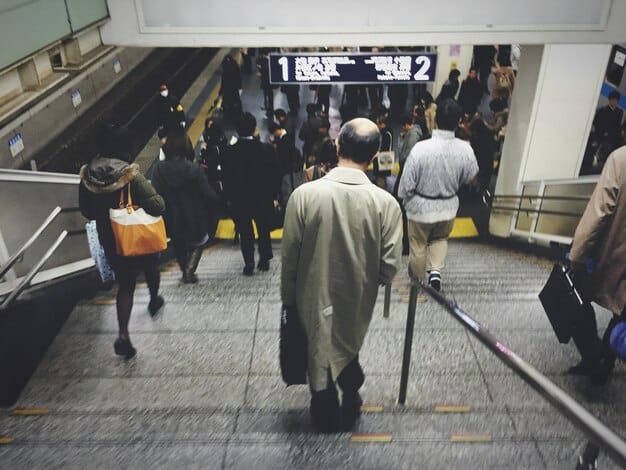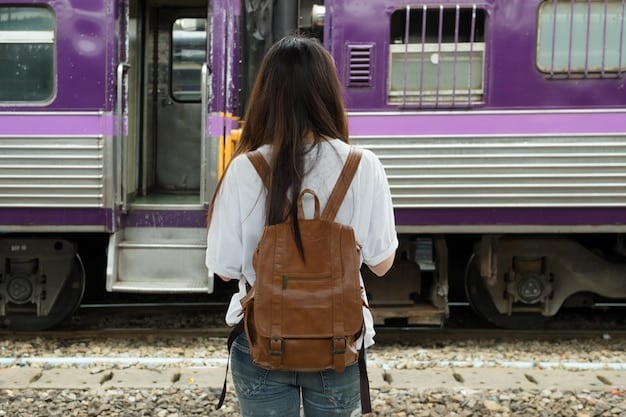Japan Public Transportation Etiquette: A 2025 Guide for US Tourists

Navigating Japan’s public transportation requires understanding specific etiquette to ensure a smooth and respectful journey for both tourists and locals, including avoiding loud conversations, refraining from eating, and respecting priority seating, which this 2025 guide outlines for US visitors.
Planning a trip to Japan in 2025? While the country is known for its stunning scenery and delicious cuisine, understanding the unspoken rules of public transport is crucial for a respectful and enjoyable experience. This guide will help you navigate Japanese trains and buses with ease, covering essential aspects of the etiquette of using public transportation in Japan, ensuring you travel like a local.
Understanding Japanese Public Transportation Etiquette
Japanese public transportation is renowned for its efficiency and punctuality. However, it’s also governed by a set of unwritten rules and social norms. Adhering to these guidelines is vital for showing respect and avoiding unintentional cultural faux pas. Let’s delve into the fundamentals.
The Concept of “Meiwaku” (不迷惑)
One of the core principles underpinning Japanese etiquette is “meiwaku,” which translates to avoiding causing trouble or inconvenience to others. This concept heavily influences behavior on public transport.
Quiet and Consideration
Maintaining a quiet and respectful demeanor is essential. This means keeping your voice down – or better yet, avoiding talking on the phone altogether – and minimizing any actions that could disturb fellow passengers.
- Avoid loud conversations: Refrain from talking loudly on your phone or with companions. Texting is preferred.
- Minimize noise: Keep the volume of your headphones low enough that others can’t hear it.
- Be mindful of your belongings: Don’t let your bags obstruct passageways or take up extra seats.
By understanding these simple aspects of “meiwaku,” you’ll be well on your way to showing respect for Japanese culture and your fellow travelers.
Boarding and Disembarking Procedures
Getting on and off trains and buses in Japan follows a specific order, and understanding this order will help you avoid causing any inconvenience.
Queuing Culture
Japanese people are known for their orderly queuing. When waiting for a train or bus, form a neat line and avoid pushing or crowding.
Letting Passengers Exit First
Always allow passengers to disembark before attempting to board. This is a fundamental rule of Japanese public transport etiquette.

- Wait patiently: Don’t try to squeeze onto the vehicle before others have exited.
- Stand to the side: Allow ample space for exiting passengers to pass.
- Be mindful of the elderly and disabled: Offer assistance if needed.
Following these guidelines ensures a smooth and efficient boarding and disembarking process for everyone involved.
Onboard Behavior: Dos and Don’ts
Once you’re on board, there are specific behaviors to be aware of, as well as things to avoid. Here are some key considerations.
Refrain from Eating and Drinking
While eating and drinking on long-distance trains (like the Shinkansen) is acceptable and even common, it’s generally frowned upon on local trains and buses. Avoid consuming food or beverages except on designated services.
Priority Seating: Who Gets It?
Priority seating is reserved for the elderly, disabled, pregnant women, and individuals with young children. Even if the seats appear vacant, avoid sitting in them unless you fall into one of these categories.
Sleeping on Public Transport
It is common to see in Japan people sleeping in subway and trains. Avoid resting your head on your neighbor’s shoulder, be mindful of where your head is going.
- Be aware of signs: Look for signs indicating the purpose of priority seating.
- Offer your seat: If you see someone who needs a priority seat, offer yours immediately.
- Be discreet: Avoid staring or making assumptions about someone’s need for a seat.
Being mindful of these practices will contribute to a comfortable and respectful environment for all passengers.
Managing Personal Belongings
How you handle your personal belongings on public transport speaks volumes about your consideration for others.
Backpacks and Large Bags
During crowded times, it’s considered polite to remove your backpack and hold it in front of you or place it on the overhead rack. This prevents you from accidentally bumping into other passengers.
Luggage on Trains
On long-distance trains, use the designated luggage racks. On local trains, keep your luggage close to you and avoid blocking aisles or doorways.

Umbrellas
Wet umbrellas should be placed in designated umbrella stands near the entrance or wrapped in a plastic bag to prevent dripping on other passengers.
Practices such as these, contribute to a more pleasant transit atmosphere.
Navigating Rush Hour
Rush hour in major Japanese cities can be incredibly crowded. Having patience and following a few guidelines can make the experience less stressful.
Expect Crowds
Be prepared for extremely packed trains and stations. Try to avoid traveling during peak hours if possible.
Follow the Flow
Move with the crowd and avoid trying to push against the flow of people. This will only cause more congestion, and potentially get you hurt.
Be Patient
Maintain a calm demeanor, even in the face of overcrowding. Getting frustrated won’t improve the situation.
- Plan ahead: Check train schedules and try to travel outside of peak hours.
- Use a travel app: Apps like Japan Travel by Navitime can help you find less crowded routes.
- Stay aware of your surroundings: Watch out for your belongings and be mindful of other passengers.
Remaining calm and aware will lead to a less stressful travel time.
Technology and Public Transport
While technology can enhance your travel experience, it’s important to use it responsibly.
Using Phones Respectfully
As mentioned earlier, talking on the phone is generally discouraged. Texting or using your phone for navigation is perfectly acceptable.
Headphones and Volume Levels
Ensure that your headphones are not leaking sound that can be heard by other passengers. Be respectful of the quiet environment.
Using Translation Apps
If you need to communicate with someone and don’t speak Japanese, use a translation app discreetly. Avoid holding up your phone and blasting audio translations.
- Download essential apps: Install helpful apps like Google Translate and HyperDia before your trip.
- Use offline maps: Download offline maps to avoid using data and to navigate without a connection.
- Carry a portable charger: Ensure your devices stay charged throughout your journey.
Using technology effectively and considerately can improve your transit experience.
| Key Point | Brief Description |
|---|---|
| 🤫 Silence | Avoid phone calls and loud conversations out of courtesy. |
| 🎒 Bag Handling | Hold your backpack in front or use overhead racks during crowded hours. |
| 💺 Priority Seats | These are reserved for elderly, disabled, or pregnant passengers. |
| 🚫 No Food | Refrain from eating or drinking on local trains and buses. |
Frequently Asked Questions
▼
Generally, it’s best to avoid talking on your phone on trains and buses in Japan. It’s considered impolite as it can disturb other passengers. Texting or using your phone quietly is more acceptable.
▼
On crowded trains, try to keep your luggage as compact as possible. Hold smaller bags in front of you, or place larger luggage on the overhead racks if available. Be mindful not to block pathways.
▼
Yes, most major train stations in Japan, especially in tourist-heavy areas, have signs in both Japanese and English. This makes navigating and finding your way around much easier for foreign visitors.
▼
The easiest ways for foreigners to pay for public transport in Japan are using an IC card (like Suica or Pasmo) or purchasing individual tickets. IC cards can be recharged and used on most trains and buses.
▼
Yes, public transportation in Japan is generally very safe. Crime rates are low, and the systems are well-maintained. However, as with any public place, it’s always wise to be aware of your surroundings and personal belongings.
Conclusion
By familiarizing yourself with these etiquette guidelines, you can ensure a smooth and respectful travel experience on Japanese public transport. Understanding and adhering to these customs will not only make your journey more enjoyable but also demonstrate your respect for Japanese culture.





